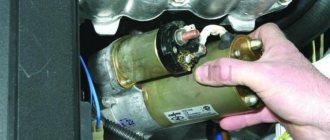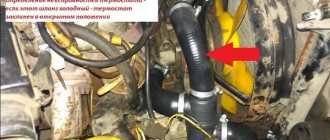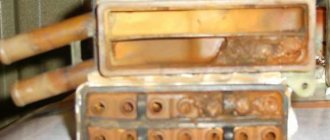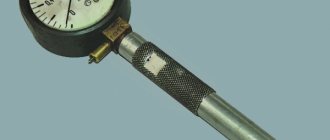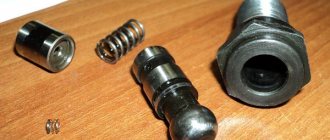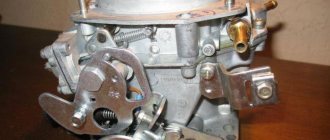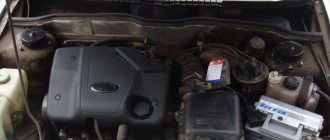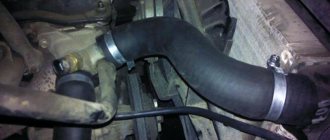What will you need for replacement?
Before starting work, you need to make sure you have:
- New working part.
- Wrenches or socket heads with a ratchet and an extension “10” and “13”.
- Phillips and slotted screwdrivers (depending on the bolt heads of the worm clamps used).
- Containers with a volume of about 10 liters for coolant, preferably low and wide; a basin is perfect for this role. If you plan to reuse antifreeze, the container must be clean.
In most cases, up to three new clamps and at least 1–2 liters of antifreeze, similar to that poured into the car, will also be useful, because it is difficult to completely eliminate coolant loss when draining it. The following will help increase the convenience and efficiency of repairs:
- Socket wrench “7” or “8”, suitable for loosening and tightening clamps.
- Pliers that make it easier to remove the factory-installed band clamps on the Classic.
- A funnel for collecting coolant, for example, cut from a plastic bottle.
Often, replacing the thermostat on a Zhiguli is combined with pouring fresh antifreeze and installing new pipes or other parts of the cooling system. In this case, it is necessary to purchase the appropriate spare parts and coolant (total filling volume is 8.65 liters, that is, a little more than 9.5 kg).
The main function and principle of operation of the thermostat on the VAZ 2107
Replacing the thermostat on a VAZ 2114
The main task of the thermostat is to not allow the engine temperature to go beyond the specified limits. If the engine heats up above 90°C, the device switches to a special mode that helps cool the engine.
All thermostats on the VAZ 2107 are equipped with three pipes
If the temperature drops below 70°C, the device switches to the second operating mode, which promotes rapid heating of engine parts.
How does a thermostat work?
The “seven” thermostat is a small cylinder, three pipes extend from it, to which tubes with antifreeze are connected. An inlet tube is connected to the bottom of the thermostat, through which antifreeze from the main radiator enters the device. The antifreeze goes through the tube at the top of the device to the S7 engine, into the cooling jacket.
The central element of the thermostat is the valve
When the driver starts the engine after a long period of inactivity, the valve in the thermostat is in the closed position, so that antifreeze can only circulate in the engine jacket, but cannot enter the main radiator. This is necessary in order to warm up the engine as quickly as possible. And the motor, in turn, will quickly heat up the antifreeze circulating in its jacket. When the antifreeze warms up to a temperature of 90°C, the thermostat valve opens and the antifreeze begins to flow into the main radiator, where it is cooled and sent back to the engine jacket. This is a large circle of antifreeze circulation. And the mode in which antifreeze does not enter the radiator is called a small circulation circle.
Thermostat location
The thermostat on the “seven” is located under the hood, next to the car’s battery. In order to get to the thermostat, the battery will have to be removed, since the shelf on which the battery is installed does not allow you to reach the thermostat pipes. All this is shown in the picture below: the red arrow indicates the thermostat, the blue arrow indicates the battery shelf.
The red arrow shows the thermostat mounted on the pipes. The blue arrow shows the battery shelf
Lada 2107 COLOR MUREN (Former) › Logbook › Replacing the VAZ thermostat. Useful tips from the Internet.
Everything you need to know about automotive antifreeze
Since I don’t have a car now, I decided to post useful tips from the Internet. You can also subscribe to my personal blog. Personal blog.
The need to perform a procedure such as replacing a VAZ thermostat can be caused by several reasons.
I would like to make a reservation right away that this is absolutely uncomplicated work and anyone, even a novice motorist, can do it.
The thermostat is installed in the vehicle cooling system to maintain the set temperature in all engine operating modes. Not only the temperature regime, but also the longevity of your engine depends on the performance of the thermostat.
Thermostat operating principle
When the engine starts, the thermostat is closed and the coolant circulates in a small circle, this is necessary to warm up the engine. In winter, this helps to warm up the interior faster and blow off the usually frozen windshield. As the engine warms up, the thermostat opens slightly and some of the liquid enters the cooling radiator, where it is partially cooled. Partial opening occurs at a temperature of about 80 degrees. When the engine reaches a temperature of 92-96 degrees, a working thermostat opens completely and the liquid begins to circulate in a large circle. On engines equipped with an electric radiator cooling fan, it should turn on.
If this does not happen, then the engine either does not warm up or overheats, which is extremely undesirable for it, especially overheating. When overheated, all engine parts begin to operate in temperature overload mode, which affects their service life.
Valve seals are especially sensitive to overheating, as they are the furthest from the oil pump and, in addition, are located in a high-temperature zone. This will further affect oil consumption and wear of the piston group. With prolonged overheating, a breakdown of the block gasket usually occurs, which is fraught with the most unpredictable consequences. Since in the event of a gasket breakdown and coolant entering the combustion chamber, the engine temperature begins to increase in square proportion.
ALWAYS - when the first signs of a change in temperature appear, pay attention to the functionality of the thermostat. It's easy to check the thermostat
With the engine fully warmed up, the bottom of the thermostat should be at the same temperature as the radiator. If the bottom of the thermostat is not hot or slightly warmed up, and sometimes even cold, it means that the coolant is circulating in a small circle and the engine is overheating. In this case, the thermostat should be replaced
Checking the thermostat is easy. With the engine fully warmed up, the bottom of the thermostat should be at the same temperature as the radiator. If the bottom of the thermostat is not hot or slightly warmed up, and sometimes even cold, it means that the coolant is circulating in a small circle and the engine is overheating. In this case, the thermostat should be replaced.
Procedure for replacing the VAZ thermostat
We drain the antifreeze by unscrewing the bolt on the cylinder block into a prepared flat container. It is convenient to have a small nylon basin for these purposes. You can get out of this situation by cutting off the side of a nylon 20-liter antifreeze canister and using it. After draining the antifreeze, unscrew the clamp of the lower pipe going to the cooling radiator, and two clamps on the cooling pipes going to the cylinder block (from the block side). We move the lower cooling pipe from the thermostat, and remove the two upper pipes from the side of the block.
As a result, you are left with a thermostat with two upper pipes. Since the cooling pipes are very flexible, move the thermostat a little towards the collectors, lift it up, it will spin the fan blades on its own, to which it will cling. Feel free to pull it up and change the thermostat. This saves a lot of time and ensures that the cooling pipe clamps are tightened in place.
We install a new thermostat, if necessary, slightly moving the cooling fan blades. We connect all the pipes, tighten the clamps, tighten the bolt to drain the fluid in the block and fill in the coolant. We start the engine and check the build quality for leaks. We warm up the engine and check the functionality of the new thermostat. This completes the replacement of the VAZ thermostat. Bon Voyage!
What is a thermostat?
Rear axle gearbox for VAZ 2107: design, repair, replacement
The thermostat is usually understood as:
- a device used to ensure a given level of ambient temperature (water, air);
- a hardware module designed to measure the temperature of the environment (water or air) and transmit a signal to the control module to activate or turn off the heating (or cooling) elements when the corresponding medium reaches a certain temperature.
Thus, there are 2 main meanings of the term in question.
In the first interpretation, the thermostat acts as an independent device that can be equipped with a variety of functions. Such as, for example, ensuring air temperature according to a schedule or in correlation with its humidity level.
A thermostat in the meaning of “hardware module” can be used as part of a wide variety of devices. For example, in air conditioners, heaters and other types of climate control equipment, in refrigerators (if we are talking about the need to maintain low ambient temperatures).
Which thermostat is better to choose and install on your VAZ-2107 if the old one has failed
Cigarette lighter VAZ 2107: device, fault diagnosis and replacement
In recent years, manufacturers of parts for VAZ have been rapidly multiplying. And not all of them offer high-quality products; most sell consumer goods that won’t last even a month.
It is better to change the thermostat in the winter, unless it is so broken that it cannot be delayed.
Options:
- Judging by the reviews of VAZ owners, the factory device works for a maximum of 3-4 years, and it begins to jam on a large circle, which is not so fatal, but also not good for the car.
- Polish WEEN products are recommended by almost everyone who has dealt with them. They keep the antifreeze temperature at any time of the year, but their operating period is 2 years from the manufacturer, but sometimes they cannot withstand more than 1.5 during intensive use of the car.
- PRAMO ThermostATO from Russia has a bad reputation because the thermoelement is poorly regulated, which does not open completely or late, turning on the fan at each stop. It often jams on a small circle, which is fraught with damage to the engine.
- BAUTLER from China is not an option when spare parts from the Land of the Rising Sun are better than domestic ones. The motor temperature does not rise above 85º C. Suitable if you remove it for winter and use it only in summer.
- PRAMO with a Polish thermoelement, made in Russia, is excellent in operation and easy to adjust. The valve does not turn on even in traffic jams, but after a long drive during the day it can remind you of itself. Warms up the engine quickly and runs for a long time in any season.
A manual for the car owner: the principle of operation of the cooling device in the car, diagram for VAZ 2107 (Zhiguli), 2114 (Lada Samara) and 2115. How to check its operation, video.
This is a device that allows you to maintain a constant engine temperature due to the operation of thermostats or due to a phase transition. Sometimes you can see thermostats with thermal insulation, which can reduce heat or cold loss. The most common one, used by everyone, young and old, is the refrigerator.
The thermostat performs the function of blocking the radiator from the flow of coolant (antifreeze), actually giving the engine time to warm up. Also, such a simple mechanism helps reduce wear on the car engine. It is closed while the engine temperature is normal, as soon as it reaches a critical point within ninety or ninety-five degrees Celsius, the damper in the thermostat opens and allows coolant to enter the engine and normalize its temperature.
You can also observe the operation of the device at home. You just need to place the thermostat in a container filled with ordinary water and put it on the stove to heat up. As the temperature of the water in the pan increases, you will be able to see the valve on the thermostat open by about two centimeters. To conduct the experiment, it is better to take a new one, and not remove it from your own or someone else’s car.
Brass and copper are the main components from which these devices are made. And the basic principle of operation of a car thermostat is hidden by a small cylinder that can be seen from the engine side. The cylinder contains a small wax ball, although not made from real wax; the melting point of the material from which it is made is 82 degrees Celsius. Wax was not chosen as a material for this element by chance; it has the property of increasing in volume under the influence of temperature, that is, making transitions from solid to liquid. When the wax melts and expands, it will create pressure that will cause the pin to fall out of the cylinder and open the valve through which coolant enters the radiator. And when the engine temperature returns to normal, the wax hardens again, taking its previous position and shape.
There are many factors that can cause problems, but corrosion is the most common. When the valve is constantly in the open position, engine cooling fluid will always flow into the radiator before entering the engine, which means the engine needs more time to reach critical temperature. And when the thermostat valve is constantly closed, the engine does not cool down and continues to gain temperature, accordingly, the car “boils” and you cannot continue driving it until the engine cools down. Experts and auto mechanics recommend that motorists replace the old one with a new one approximately every two years. Read, in a VAZ 2110-2111 car.
Thermostats for VAZ (Lada) 2101/2103/2106
for repair of VAZ (Lada) 2101/2103/2106
I took the Luzar thermoelement half a year ago, so far it’s good, we’ll see.
I bought it in the store on 03/04/19. I didn’t check it, I installed it right away.. I filled it with distilled water, left it for the summer, opened to a large circle at 65 degrees.. For the winter I filled it with Antifreeze 10 kg FELIX-35 euros.. In winter the thermostat leaked and underheated.. Now I’m looking for something better.
Overall it's sad. Auto VAZ 21063.
Luzar was a year old and began to hang out closed. The temperature was kept at 95-97 on the highway at 120, in the city it was 97 - stable. I installed the Pramovsky one, drove it for a drive, the temperature remains stable at 88-87, rarely 90. The stove heats normally.
Yes, close to the topic, the Luzar radiator was new, a little over a year old, leaked, a nit. Filled with high gear. My annual mileage is about 35-38tkm.
Worth Luzar. Works fine. Along the highway the temperature stays around 80, both in summer and winter. In the city the fan also rarely turns on.
good thermostat Vernet made in France. It has been working for me for a long time.
I used a Gates thermostat. Now it works well. True, I recently installed it, so I can’t say anything about reliability.
Write your review about thermostats
Help others - tell us about your experience using the spare part.
- loading.
- loading.
- loading.
- loading.
- Vectra
- Mokka
- Antara
- Astra
- SPORTS TOURER
- Meriva
- Zafira Tourer
I have been using antifreeze-synthesis Rosdot 6 for more than 5 years and am satisfied. The price is not the lowest, but the quality justifies it.
LYNXauto tie rods only have 2 reviews. Perhaps you will add another one?
The Inspector DVR only has 30 voices! Do you recommend?
The LYNXauto timing chain has its first review!
RUNWAY car wax has only 15 votes! Do you recommend?
ALCASTA alloy wheels have only 8 reviews. Perhaps you will add another one?
RUNWAY anti-gravel products have only 4 reviews. Perhaps you will add another one?
There are already 50 manufacturers participating in the auto rating of motor oils for Ford Focus!
The SAT timing belt kit only has 10 votes! Do you recommend?
Voted FOR EBC brake pads on the rating page
Voted FOR Brembo brake pads on the rating page
Voted AGAINST LYNXauto brake pads on the rating page
I've driven about 20k on them. The pads are like new, but there are practically no brakes and at first I thought that they had not gotten used to it.
There are already 25 reviews of Matrix toolkits.
There are already 50 reviews of Hi-Gear washer fluid.
There are already 5 manufacturers participating in the auto rating of mud flaps for Ford Focus!
There are only 14 manufacturers in the ranking of the best glow plugs. Perhaps you know of someone else?
VAZ (Lada) 2113/2114/2115
There are already 5 manufacturers participating in the auto rating of window regulators for VAZ (Lada) 2113/2114/2115!
The SONY radio already has 150 voices!
The car began to pull to the left. I looked at the car in the pit, but I couldn’t find the reason. I decided to go to the service station. Guys, story.
17 March 2021, 03:24
There are already 40 manufacturers participating in the ranking of the best starters!
17 March 2021, 01:47
There are already 15 manufacturers participating in the ranking of the best liquid rubber!
March 17, 2021, 00:21
I apologize, I made a mistake in my review. There is a missing part about the fact that the husband did something with the car for the first time.
March 16, 2021, 10:16 pm
Do you want another joke? Again from their blog with Drive2 article Brake pads: what you should pay attention to when choosing.
16 March 2021, 17:23
There are already 40 manufacturers participating in the ranking of the best automobile compressors!
16 March 2021, 16:10
I voted AGAINST Torch spark plugs for VAZ (Lada) 2113/2114/2115 on the auto rating page.
16 March 2021, 08:50
Could it be that the pads turned out to be fake? A piece of stone has fallen off - this is a critical flaw. Stones crack.
15 March 2021, 10:25
There are only 13 manufacturers in the ranking of the best crankshaft oil seals. Perhaps you know of someone else?
14 March 2021, 19:25
There are only 14 manufacturers in the ranking of the best air conditioner radiators. Perhaps you know of someone else?
FIFA Mobile GromoBOY –
14 March 2021, 15:31
Voted FOR NiBK brake pads for Toyota Carina on the auto rating page.
13 March 2021, 16:34
Voted FOR the SAKURA air filter for Nissan Primera on the auto rating page.
How to correctly determine that the device is in working condition?
We warm up the engine to such a temperature that the needle does not reach the critical value, and turn it off. We open the hood, find a hose on top of the radiator (a black rubber hose with a metal clamp at the end) and the same one on the bottom. Then, very carefully, they may be quite hot, touch them. If one of them becomes hot, and the other is still cold, and the sensor shows a high engine temperature, this means that most likely the liquid does not enter the engine, but is retained in the radiator, and you need to change the thermostat to a new one.
There is another way of checking, better known as “folk”. It echoes the “experiment” that was described above, to observe the process of the thermostat, only this time you will have to put the thermostat, the functionality of which you doubt, removed from your car, into a container with water, and then the procedure is repeated as Once the water reaches a temperature of 87–90 degrees, the valve should open, however, if this does not happen, then the thermostat is no longer suitable for operation. It is also worth remembering that different thermostats may have different critical valve opening temperatures, so when purchasing a new one, check this with the seller. Since it is no secret to the driver that it is impossible to install a thermostat in a car that has a high valve opening temperature - the engine will not cool.
Video, checking the thermostat VAZ 2101-2107 and Tama (Toyota):
A thermostat is a device that regulates the temperature of the fluid in the engine cooling system. In its standard version, it is 5 cm in diameter and is located between the engine and the radiator. The operation of the thermostat allows you to maintain a constant temperature of the motor due to thermostats or due to the implementation of a phase transition.
The device blocks the radiator from coolant, thereby allowing the engine to warm up. In addition, this inherently simple mechanism reduces wear on the car engine. The device is closed if the engine temperature is normal, but as soon as it reaches a critical level of 90-95 ° C, the damper in the thermostat opens, which allows coolant to enter the engine.
How to check the thermostat
You can diagnose the thermostat without involving specialists. The procedure for checking it is quite simple, but to do this the part will need to be dismantled. We will consider the process of removing it from the engine below. Now let’s imagine that we have already done this and the thermostat is in our hands. By the way, this could be a new, just purchased device, or restored by boiling in oil.
To test the thermostat, we only need a kettle with boiling water. We place the device in the sink (sink, pan, bucket) so that the pipe connecting the part to the engine is at the top. Next, pour a small stream of boiling water from the kettle into the nozzle and watch what happens. First, the water must pass through the bypass valve and pour out from the middle pipe, and after heating the thermoelement and the main valve is activated, from the bottom.
Thermostat malfunctions and their identification
The VAZ 2107 thermostat (injector) is a simple device, so it has only 3 possible faults:
- It does not open, constantly passing antifreeze through the small circuit. The engine does not cool down.
- It opens only partially, which reduces engine cooling efficiency.
- It does not close, constantly passing antifreeze through a large circuit (through the radiator). In this case, the engine does not warm up to the optimal operating temperature.
To check the functionality of the thermostat, you should check at what temperature of the antifreeze the valve begins to open. It is also necessary to check the maximum valve stroke. Given the non-separable and opaque body, it is impossible to fully test the thermostat without a special stand. But it is quite possible to carry out a simple test of functionality simply by touch.
If the thermostat is working properly, the tank at the bottom of the radiator does not warm up immediately after starting the engine, but after the temperature gauge shows 80–85 degrees (the instrument needle stops 4 mm from the red zone of the instrument scale).
If the lower tank starts to heat up immediately, this indicates that the thermostat is not closing. If even after warming up the antifreeze the lower reservoir remains cold, the thermostat jams (does not open).
Insufficient valve hot-pot can be determined by the fact that the engine is overheating (the latter, however, may have other reasons).
If there is any malfunction of the thermostat, it must be replaced.
Signs of a broken thermostat
There are a number of signs that clearly indicate that the thermostat is faulty:
- The light on the instrument panel is constantly on, indicating that the engine is overheating. This usually happens because the thermostat valve has closed and is stuck in that position;
- The engine warms up very poorly. This means that the thermostat valve does not close tightly. As a result, antifreeze flows through both the small and large cooling circles and cannot warm up in a timely manner;
- After the engine starts, the lower thermostat tube heats up literally within a minute. You can check this by simply placing your hand on the nozzle. This situation indicates that the thermostat valve is stuck in the fully open position.
If any of these symptoms are detected, the driver should replace the thermostat as soon as possible. If the car owner ignores the above symptoms, this will inevitably lead to overheating of the engine and its jamming. It is extremely difficult to restore an engine after such a breakdown.
Table
| Thermostat | Thermostat |
| What do they have in common? | |
| A thermostat in the meaning of “independent device”, designed to maintain a stable ambient temperature, is a thermostat | |
| The thermostat in the meaning of “hardware module” is included in any thermostat (refrigerator, air conditioner) | |
| What is the difference between them? | |
| The term "thermostat" may be used to refer to a single piece of hardware rather than a complete device | The term “thermostat” in most cases is used to designate a complete, independent device that includes a thermostat (with the exception of a thermostat included in non-climatic equipment, such as car cooling systems) |
| In the meaning of “independent device” it can be used to control the ambient temperature according to a schedule or in relation to air humidity | Not designed to control temperature according to a schedule or in relation to air humidity - used only to maintain a given level |
To replace the thermostat on VAZ 2106 cars, you need to drain some of the coolant by unscrewing the drain plug on the cylinder block. It is also necessary to remove the battery, which will interfere with our ability to carry out repairs to replace the thermostat. Next, loosen the clamps securing the hoses to the thermostat and disconnect the hoses, then remove the thermostat.
After removing the thermostat, it must be checked for functionality; to do this, lower it into a container with water heated to 78-80 degrees and, with constant stirring, continue to heat the water to 87-90 degrees. The thermostat valve should slowly begin to open; if this does not happen, the thermostat must be replaced.
Checking the thermostat on VAZ 2105, 2107, 2108, 2109, 21099 cars
Let's check the functionality of the thermostat of the carburetor engine cooling system of VAZ 2105, 2107, 2108, 2109, 21099 cars.
To check the thermostat, assess the correctness of its operation (whether the valve is jammed or not), you need to know its role in the car's cooling system and the principle of operation. The thermostat separates two circles of the cooling system (small and large) and has two valves: bypass and main. While the engine is warming up, coolant circulates through the small circle and the open thermostat bypass valve. The thermostat prevents it from mixing with the liquid from the large circle and thereby helps the engine warm up quickly.
More details about the operation of the thermostat on the page: “Thermostat operation diagram”
As it warms up (coolant temperature is about 87º - 2108, 2109 and 80-85º - 2105, 2107), the bypass valve closes, and the main one opens, and the liquid flows into a large circle. At a temperature of 102º (94º for VAZ 2105, 2107), the main thermostat valve is fully open, and the additional one is closed. Circulation occurs through a large circle, providing the required temperature conditions for normal engine operation.
Therefore, the simplest way to check the functionality of the thermostat is by touch, directly on the car. When operating correctly, its upper part warms up first, and then the lower part.
The procedure for checking the thermostat on VAZ 2108, 2109, 21099 cars without removing it from the engine
When the engine warms up, circulation occurs in a small circle. Warms up: cylinder block, cylinder head, carburetor heating block, stove, upper part of the thermostat. We check the heating of the thermostat with our hands: its upper part should be warm, and after a few minutes it becomes hot. The bottom of the thermostat remains cold. In addition, the lower hose to the radiator will also be cold, and the upper one will be slightly heated.
After some time, the lower part of the thermostat and the lower radiator hose suddenly become hot - this opens the main thermostat valve. Circulation went through the radiator (large circle).
Lower and upper parts of the thermostat for the VAZ 2108, 2109, 21099 engine cooling system
The procedure for checking the thermostat on VAZ 2105, 2107 cars without removing it from the engine
The check is similar to the check on VAZ 2108, 2109, 21099, only when circulating in a small circle, the following elements of the cooling system warm up: the cylinder head tee, the upper hose to the radiator, the upper radiator tank, the heater. The lower part of the radiator and its lower hose remain cold. After the thermostat operates at a temperature of 80-85º (the coolant temperature gauge needle is 3-4 mm from the red zone), the lower part of the thermostat and the lower radiator tank warm up.
Lower and upper parts of the thermostat for the VAZ 2104, 2105, 2107 engine cooling system
Checking the removed thermostat
You can check the removed thermostat of VAZ 2105, 2107, 2108, 2109, 21099 cars. To do this, immerse it in a container with hot water (preheating temperature 73-75º). We heat the water further, stirring it, and observe the movement of the main thermostat valve. When the valve begins to open (approximately 1 mm), the temperature of the liquid should be measured. If the thermostat is working, it will be 81±5º for VAZ 2105, 2107 and 87±2º for VAZ 2108, 2109, 21099. A faulty thermostat should be replaced.
Notes and additions
— The stroke of the main thermostat valve at 102º for VAZ 2108, 2109, 21099 is about 8 mm. For VAZ 2105, 2107 at 94º from 6 to 8 mm.
About choosing a thermostat for VAZ 2107
When the standard thermostat on the “seven” fails, the car owner inevitably faces the problem of choosing a replacement thermostat. There are many companies on the market today, both domestic and Western, whose products can also be used in the VAZ 2107. Let’s list the most popular manufacturers.
Gates thermostats
Gates products have been represented on the domestic auto parts market for a long time. The main difference between this manufacturer is the wide range of thermostats produced.
The range of Gates thermostats is very wide
Here are classic thermostats with valves based on industrial wax, and thermostats with electronic control systems created for more modern machines. Relatively recently, the company began producing case thermostats, that is, devices supplied complete with a proprietary case and pipe system. The manufacturer claims that the efficiency of a motor equipped with their thermostat will be maximum. Judging by the consistently high demand for Gates thermostats, the manufacturer is telling the truth. But you have to pay for high reliability and good quality. The price of Gates products starts from 700 rubles.
Luzar thermostats
It will probably be difficult to find a “Seven” owner who has not at least once heard about Luzar thermostats. This is the second most popular manufacturer in the domestic auto parts market. The main difference between Luzar products has always been the optimal price-quality ratio.
Luzar thermostats have an optimal ratio of quality and price
Another characteristic difference is the versatility of the produced thermostats: a device suitable for the “seven” can be installed on the “six”, “kopek” and even “Niva” without any problems. Finally, you can purchase such a thermostat in almost any auto store (unlike Gates thermostats, which cannot be found everywhere). All these points made “Luzarovsky” thermostats incredibly popular among domestic car enthusiasts. The cost of the Luzar thermostat starts from 460 rubles.
Finord thermostats
Finord is a Finnish company specializing in automotive cooling systems. It produces not only various radiators, but also thermostats, which are highly reliable and very affordable. The company does not provide any specific information about the production process of its thermostats, citing trade secrets.
The Finnish company Finord produces good thermostats at a reasonable price
All that can be found on the official website is assurance of the highest reliability and durability of Finord thermostats. Judging by the fact that the demand for these thermostats has remained consistently high for at least ten years, the Finns are telling the truth. The cost of Finord thermostats starts from 550 rubles.
Wahler thermostats
Wahler is a German manufacturer specializing in thermostats for cars and trucks. Like Gates, Wahler provides car owners with a wide range of models, from electronic thermostats to classic ones with industrial wax. All Wahler thermostats are thoroughly tested and are characterized by the highest reliability. These devices have only one problem: their price is very high. The simplest Wahler single-valve thermostat will cost the car owner 1,200 rubles.
Wahler thermostats are high quality and high price
Here we should also mention the counterfeits of this brand. Now they are becoming more and more common. Fortunately, the fakes are made very clumsily, and are given away primarily by the poor quality of packaging, printing and the suspiciously low price of 500–600 rubles per device. A driver who sees a “German” thermostat sold at such a more than modest price should remember: good things have always been expensive.
So which thermostat should a car enthusiast choose for his “Seven”?
The answer is simple: the choice depends only on the thickness of the car owner’s wallet. A person who is not short of money and wants to replace the thermostat and forget about this device for many years can opt for Wahler products. If you don’t have a lot of money, but you want to install a high-quality device and at the same time have time to look for it, you can choose Gates or Finord. And finally, if money is really tight, you can simply install a Luzar thermostat from the nearest auto store. As they say - cheap and cheerful.
Which thermostats to choose for VAZ (Lada) 2101/2103/2106?
Last month, PartReview users preferred LUZAR. 60% of positive votes belong to this manufacturer.
Gates thermostats took second place – 20%.
Vernet closes the top three with 20% of the votes.
In the general rating of thermostats, which takes into account the opinions of owners of different brands and models of cars, these brands occupy the following positions:
- LUZAR received 7th place, PR score - 65. Data from 69 reviews and 220 votes are taken into account.
- Gates was ranked 10th with a PR score of 56 based on 69 reviews and 85 votes.
- Vernet - 6th place, and the PR score was 70. Data from 59 reviews and 181 votes are taken into account.
Features of checking the thermostat
Testing the thermostat can be done without special equipment. To determine the quality of the thermostat, you need to open the hood of the car and start the engine in a cool state. Within a few minutes, the radiator pipe should maintain its initial temperature; it can be determined tactilely by placing your hand on the hose. When the operating range of 80-90 C is reached, part of the device and the nozzle area will quickly heat up. It is this sequence that characterizes the proper operation of the thermostat. The operating temperature of the VAZ 2107 injection engine can reach 95 degrees in summer weather.
The main malfunctions of the thermostat leading to the need for thermostat replacement:
- the engine is “boiling”, the valve is stuck closed;
- the engine takes a long time to warm up, the valve is stuck open. In winter, this leads to weak heating and poor heating of the interior;
- The valve does not close or open completely. In the summer it will boil, and in the winter it will be difficult to warm up.
Before replacing, you can check the thermostat in one more way. In this case, take a pan, add water and bring to a boil. In a cold state, the thermostat bypasses through holes 1 and 3; if it is heated in boiling water, it will bypass through 3 and 6.
If there is a need to replace a part, then which thermostat is better for the VAZ 2107, of course, everyone chooses for themselves from their own experience, but we can recommend some manufacturers. The preference of the majority is given to PRAMO - a Russian development with a Polish thermoelement due to accelerated heating and long service life. Also worthy of attention are the Chinese BAUTLER and the Polish WEEN, a good option from.
You can consult with car service workers who are familiar with the quality of their work. From practice, perhaps the worst is the Chelyabinsk one from.
Types of thermostats
Externally, if you take the thermostats of the Niva and VAZ 2101 (kopecks), the differences will not be visible. They have differences inside, the pipes are located differently.
Types of VAZ thermostats:
- Thermostat 2101-2107. The valve began to lock when it reached 80 degrees, and fully opened when it reached 95 degrees.
- Almost the same ones are installed on the VAZ Niva, only the angle between the pipes is about 180 degrees.
- The VAZ 2108 thermostat is installed on all VAZ models with carburetor engines of various modifications. The thermostat valves of front-wheel drive VAZs operate 7 degrees later than those of classic models.
- The thermostat of the VAZ 2110 is the same as the classic one, but the pipes are located in a mirror image. There is no small pipe for air outlet.
- The VAZ 2112 thermostat is made for VAZ injection engines. The valve opens when the temperature reaches 85 degrees.
Replacing the thermostat VAZ-2107
First, the antifreeze is drained from the cooled engine. Using a slotted screwdriver with a thin blade or pliers, loosen the clamp securing the hose supplying antifreeze from the radiator to the thermostat pipe. Disconnect this hose.
Use a Phillips screwdriver or an 8 mm socket wrench to loosen the clamps securing the hoses to the pipes of the cylinder block and pump. Remove the thermostat along with the hoses.
In any power unit, the cooling system performs one of the most important functions. When the engine overheats, very disastrous and sometimes irreparable consequences arise - from the combustion of the cylinder head gasket to the deformation of the head itself. But in both cases, repairs will cost you a pretty penny.
Even when the car operates in less aggressive temperature conditions, but still at a level below acceptable levels, it will have a detrimental effect on many resources, and in winter it will also result in a cold interior.
That is why correct and stable operation of car cooling is very important. One of the devices that guarantees optimal operation of the cooling system is the thermostat. This relatively small unit monitors and adjusts the temperature of the antifreeze in the cooling system.
Changing the thermostat on a classic - explanation of the replacement steps
- We drain the antifreeze, we discussed how to do it correctly in the article on how to change the coolant in a VAZ. In our case, you can close the cabin heater tap so as not to drain the liquid from the stove.
- We remove the terminals from the battery and pull it out of the car.
This should be done to facilitate access to the thermostat when replacing it.
Additionally, removing the washer reservoir will help free up space for work on models with an injection engine. To do this, pull off the terminals of the motor wires, remembering their location, move the tank up the bracket and place it in the air intake box. The flexible tube going to the windshield nozzles is long enough, so you can do without disconnecting it and draining the washer fluid.
- Unscrew the clamps and remove them.
It is advisable to replace them with new ones. Because, over time, they stretch, and when the hose is pressed again, they can leak or unscrew on their own. Ideally, you should use spring clamps, used on modern cars, instead of tape or worm clamps.
When installing such connecting elements, it is extremely important to choose the correct diameter.
- We remove the thermostat and replace it with a new one.
It is best to first release the part from the shortest pipe leading to the cylinder block by pulling the assembly towards you. After this, removing the upper hose attached to the cylinder head and the side hose (to the radiator) will not be difficult.
At the same time, we carry out diagnostics of the hoses for elasticity and absence of ruptures and cracks. Otherwise, we change them. It is advisable to inspect the pipes before carrying out work, so that, if necessary, you can purchase a new spare part in advance.
- Before installing a new thermostat, it must be inspected.
We carry out a visual inspection. If there are burrs or casting defects on the nozzles, where the hose is attached, they should be treated with sandpaper or a file. We check that the insides of the thermostat are intact and that the valves are not stuck in the open position.
Video on how to check the functionality of a new thermostat before replacing it:
- We install the new thermostat in place.
We put the hoses on the pipes and tighten them with clamps.
Pour coolant into the system. We displace the air and check for leaks in the places where the thermostat is attached with hoses. If necessary, tighten the clamps. I described in detail how to properly fill in new antifreeze and not air out the system in previous articles; the link is provided at the beginning of the review.
How to change a thermostat
Before replacing the thermostat, check the rigidity of the pipes. The fact is that if these parts have been standing for a long time, they become rigid and crack at the most inopportune moment, so it is better to replace them in advance. To replace the thermostat on a VAZ 2107 you will need:
Thermostat VAZ 2107
The replacement process is not complicated and can be done independently. Dismantling is carried out both with the help of an inspection hole and without it. Depending on the type of engine, carburetor or injection, the necessary stages of work are selected. Installing the latter is somewhat more complicated and requires additional tools.
The coolant is drained from the engine, the latter must cool completely after previous operation. For convenient operation, remove the battery. The heater tap is opened and the radiator filler cap is removed. After preliminary installation of the container, the drain of the cylinder block and radiator opens. Next, you need to remove the old clamps and carefully release the thermostat from the pipes.
For reliability, lubricate the pipes with sealant. After stable fixation of the working part, it is securely secured with clamps, and the battery is also returned to its original place. If the pipes are unsuitable, they can also be replaced with new ones. Next, add antifreeze and test the thermostat using the above method or using a pyrometer.
How to replace a thermostat
- On a cold engine, open the neck of the radiator and expansion tank, unscrew the plug on the cylinder block, and drain all the antifreeze.
- We unscrew the clamps, remove the device and replace it with a new one;
- Taking this opportunity, we wash the cooling system with a special wash, preferably a branded one, with orthophosphoric acid and fill it with fresh antifreeze.
After this, you need to check the operation of the thermostat
Thus, replacing the device is an easy operation that can save a lot of money if you take into account the possibility of the engine jamming
The vehicle's thermostat is used to maintain the engine operating temperature within specified limits. A faulty device must be replaced, since operating the machine with it can lead to overheating of the engine or a decrease in its service life.
Checking the Thermostat
The problems described above can appear at any time. To avoid engine overheating and damage, you need to know how to check the thermostat directly on the car and after dismantling it at home.
It is important to know that after starting the engine, the thermostat is still closed and the coolant flows through a small circuit (through the cooling jacket and the stove). This allows the power unit to quickly reach the desired temperature
As soon as the required level is reached, the valve opens and coolant flows through the main radiator.
Understanding this principle is very important when checking the thermostat. Therefore, we invite you to familiarize yourself with the diagram
Therefore, we invite you to familiarize yourself with the diagram.
Let's consider two diagnostic options.
Without dismantling
The easiest way is not to remove the unit, but to check it directly on the car. The main condition is a cold engine.
The diagnostic process begins with starting the power unit and warming it up for 2-3 minutes at idle.
This time is not enough for the engine to warm up and the coolant to circulate in a large circle, so the radiator is not yet connected to the general cooling system.
To check that the system is working correctly, touch the pipe that goes to the top of the main radiator with your hand.
The pipe should be cold, which signals the passage of coolant in a small circle (only through the engine and stove).
Therefore, the valve of the device under test is in the closed position (as it should be at this stage).
Continue to monitor engine cooling system performance. As soon as the coolant warms up to 90 degrees Celsius (can be controlled by the sensor), touch the inlet pipe. The thermostat should be open at this moment.
In this case, the coolant is directed in a maximum circle (encompassing the radiator). In such a situation, the pipe that extends from the radiator will be well heated.
By the way, the lower pipe of the cooling system, extending from the radiator, will also be hot.
If the condition described above is not met, then we can talk about a breakdown of the thermostat and its incorrect operation (for example, the valve could be jammed). In such a situation, you need to check it and replace it if necessary.
The second option is also possible, when after starting the engine the tube leading to the radiator warms up almost immediately.
One of the reasons is the valve jamming in the open position and, as a result, the coolant moving in a large circle at once.
The result in this case is obvious - the power unit will not operate in normal mode due to the impossibility of reaching normal temperature conditions.
Such a malfunction is not dangerous for the engine, but can lead to increased fuel consumption.
Situations are possible when the valve “hangs” in the middle position, that is, it does not close or open fully. The problem is diagnosed by the long warm-up of the power unit.
It is more difficult to determine a malfunction in “field” conditions.
In this case, checking the thermostat can only be done by dismantling it.
Checking the functionality of the thermostat by removing
If it is not possible to determine the breakdown without dismantling, then proceed as follows:
- pour the antifreeze into a container prepared in advance. In this case, first install the vessel, and then unscrew the drain plug. To speed up the process of coolant release, unscrew the cap on the expansion tank;
- If there is no such plug, then place a container under the lower part of the radiator pipe. loosen the clamp that holds the pipe to the radiator and remove the pipe itself. Wait until the coolant is completely drained into the container, and then proceed to dismantle the thermostat;
- dismantle the outlet pipe;
- take the thermostat and go to the kitchen. There you will need a stove, a saucepan (or any other metal container) and water. Pour in the liquid and set the pan to heat. Then place the assembly in water so that the body part does not touch the walls of the container itself;
- install a special thermometer in the water and monitor changes in its readings, as well as the actions of the valve itself;
- as soon as the desired temperature is reached, the unit should operate and open. This is possible thanks to the precise operation of the device’s working substance (artificial wax). When heated, the wax expands and allows the valve to operate. If it still does not work at the required temperature, then we can draw conclusions about the unsuitability of the entire assembly (we will talk about the operation temperature below);
- remove the thermostat from the water and let it cool. If the node worked earlier, it should close after a while. Again, if this does not happen, then it needs to be changed.
The principle of operation and repair of the VAZ 2106 thermostat
The VAZ 2106 thermostat is a device whose main task is to control the normal temperature regime of the internal combustion engine. Used with a liquid cooling system. When the engine is cold, the engine cooling liquid does not circulate through the heat removal lines. When the engine reaches 95 °C, the thermostat allows coolant to circulate. Thanks to this temperature regulator, the car's power plant warms up much faster, which allows you to extend the service life of parts of the crank and gas distribution mechanisms, as well as elements of the cylinder-piston group.
We need a “classic” thermostat.
Which activate heating or, conversely, cool the device or elements that affect the ambient temperature.
In turn, the term “thermostat” can be used to designate a hardware component of devices whose main function is not climate control. For example, when it comes to automotive cooling systems.
Secondly, the difference between the terms in question can be traced even if it is agreed that they are used as synonyms.
The fact is that among technical specialists it is customary to consider any device designed to maintain a constant air temperature as a thermostat. In any case, it will be a thermostat in the sense of an “independent device”.
However, if the thermostat is designed to control the ambient temperature according to a schedule or in correlation with air humidity, then it would not be very correct to call it a thermostat. In this sense, the thermostat may differ from the thermostat in terms of functionality.
A small table will help us understand the difference between a thermostat and a thermostat.
What will you need for replacement?
Before starting work, you need to make sure you have:
- New working part.
- Wrenches or socket heads with a ratchet and an extension “10” and “13”.
- Phillips and slotted screwdrivers (depending on the bolt heads of the worm clamps used).
- Containers with a volume of about 10 liters for coolant, preferably low and wide; a basin is perfect for this role. If you plan to reuse antifreeze, the container must be clean.
In most cases, up to three new clamps and at least 1–2 liters of antifreeze, similar to that poured into the car, will also be useful, because it is difficult to completely eliminate coolant loss when draining it. The following will help increase the convenience and efficiency of repairs:
- Socket wrench “7” or “8”, suitable for loosening and tightening clamps.
- Pliers that make it easier to remove the factory-installed band clamps on the Classic.
- A funnel for collecting coolant, for example, cut from a plastic bottle.
Often, replacing the thermostat on a Zhiguli is combined with pouring fresh antifreeze and installing new pipes or other parts of the cooling system. In this case, it is necessary to purchase the appropriate spare parts and coolant (total filling volume is 8.65 liters, that is, a little more than 9.5 kg).
Common Causes of Thermostat Problems
During the operation of the car, the following thermostat breakdowns and the reasons for their occurrence are possible.
- INCREASED HEATING TIME OF THE POWER UNIT. The engine operates unstably (for example, troits), which leads to excessive vibrations of the device valve and damage to its seat. Due to exposure to strong vibration, damage to the temperature-sensitive element occurs. The result is that coolant gets inside the unit (wax comes out), which leads to a malfunction of the device, which stops opening or closing the valve when the required temperature level is reached.
- THE OPENING OCCURS EARLIER OF TIME. The cause of such a breakdown may be the ingress of coolant into a special element that controls the temperature level of antifreeze in the system. The result is an increase in the total volume of filler and premature opening.
- THE THERMOSTAT OPENING IS DELAYED. The reason is the appearance of a leak of a special filler that allows the device to respond to temperature changes. Changing the volume of this element downward will require more heating to open. The result is that the thermostat operates with a certain time delay.
- THE ENGINE OVERHEATS REGULARLY. For example, there may be situations where the thermostat allows coolant to pass through on time, but the engine still overheats. The reason is that the fluid is not passing through the main radiator, but is being discharged through the return line back into the engine.
- THERMOSTAT IS NOT COMPLETELY OPEN. The reason is mechanical damage. The result is a small volume of liquid entering the radiator, and, as a result, overheating of the power unit.
- NOT COMPLETELY CLOSED. This is possible when coolant “sneaks” into the working element. Due to the increase in the volume of the working element, the valve disc cannot close completely.
- INCORRECT OPERATION OF THE DEVICE. For example, opening and closing it ahead of time. This is possible in case of failures in the factory settings and excessive overheating of the cooling system of the power unit.
- DESTRUCTION OF RUBBER SEALING. Due to a breakdown, oil gets into the coolant. The latter acts as a solvent for the rubber seal (rubber simply cannot withstand aggressive influences).
The thermostat is not working. Signs and symptoms
Only the most irresponsible motorist can fail to pay attention to the incorrect operation of the VAZ 2110 engine cooling system. Constant overheating or, conversely, operation at a low coolant temperature threatens not only a high level of wear of rings, pistons and liners. In critical cases, overheating can cause the piston to stick or seize, rotate the main or connecting rod bearings, bend the valves, destroy the camshaft and many other unexpected troubles.
Old and new thermostat valves. Wear is obvious
How does the VAZ 2110 thermostat work?
Theoretically, a tens thermostat is a regular valve that is controlled by a temperature-sensitive element.
Depending on the temperature of the coolant, it either closes the gate and sends antifreeze in a small circle, bypassing the main radiator, or opens it and forces the liquid to circulate in a full circle, including the cooling radiator, heater, engine water jacket, and throttle heating system.
As shown in the diagram, the thermostat is designed as a spring-loaded bypass valve. Under the influence of a spring, it is in the open position and passes liquid in a full circle through the radiator of the cooling system. In this case, the liquid cools faster, but, naturally, warms up very slowly, especially in winter.
Since we know that the engine can normally operate only at a temperature in the range of 97-105 degrees, then in the case of constant circulation of fluid in a large circle in the cold season, warming up the engine occurs very slowly. This causes increased fuel consumption and severe wear of rubbing engine parts.
Scheme of the VAZ 2110 cooling system with injection engine 21114-21124
That is why the thermostat valve should open only when the antifreeze temperature reaches 95-98 degrees. Naturally, in winter it would be better for him to work later, and in summer earlier. But since the thermostat in the VAZ 2110, on Priors and Kalinas, as well as Grants and Vestas does not have an electronically controlled servo drive, the valve response temperature is regulated only by replacing the thermostat with another model with a different response threshold. There are plenty of them on sale and experienced drivers recommend installing devices with a valve opening temperature of about 95 degrees for the winter, and with a temperature of about 85-90 degrees for the summer.
Signs of a malfunction of the VAZ 2110 thermostat
We understand that even such a simple mechanism as a thermostat valve is susceptible to a variety of breakdowns. They can be caused either by the disgusting quality of the new parts purchased, or by violation of operating rules by the driver himself. Since the valve is mechanical, there can be many reasons for its failure - from bad or worn out antifreeze, to corrosion or mechanical wear of the valve drive. The main signs of a thermostat malfunction are obvious:
- Engine overheating without special loads. This indicates that the thermostat valve thermocouple did not work or the radiator fan did not turn on. We have dealt with the second problem in more detail here. The first one is even easier. To determine the causes of overheating, it is necessary to dismantle the thermostat and check the functionality of its valve.
To check the thermostat, you must remove the cover assembly with the valve. - The engine does not warm up. Again, all the questions are about the thermostat valve and the modes of turning on the cooling radiator fan. In this case, the valve is stuck in the open position and does not allow the fluid to warm up to normal. This problem is especially relevant in the cold season.
Coked thermostat valve - The most difficult situation to diagnose is when the valve is unstable or stuck in an intermediate position between a closed and open channel. In these cases, trouble comes from both sides - the engine can take a long time to warm up and boil quickly.
Primary diagnostics of the thermostat can be carried out directly on the engine. To do this, you do not need to drain the antifreeze and remove the thermostat housing. This is done quite simply. Initially, the engine should be cold. Open the hood, start the engine and follow the arrow of the coolant temperature gauge. The lower radiator pipe should warm up quickly and you can feel this by touching it with your hand. The upper pipe should remain cold until the temperature gauge needle rises to 70-80 degrees. The temperature sensor will not give particular accuracy, but approximately we will know that:
- if, after warming up to 80 ˚C, the upper pipe does not begin to warm up slowly, the problem is in the thermostat valve;
- After warming up the engine, the upper pipe warms up normally, the stove blows hot air - our fears were not confirmed and the thermostat is normal.
